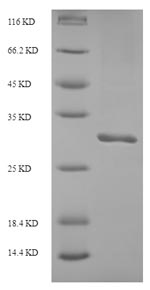The region for expressing recombinant Human ITIH5 contains amino acids 35-161. This ITIH5 protein is expected to have a theoretical molecular weight of 30.6 kDa. The ITIH5 protein was expressed in e.coli. Fusion of the N-terminal 6xHis-SUMO tag into the ITIH5 encoding gene fragment was conducted, allowing for easier detection and purification of the ITIH5 protein in subsequent stages.
Human inter-alpha-trypsin inhibitor heavy chain H5 (ITIH5) functions as a key player in extracellular matrix stability and inflammation regulation. By interacting with hyaluronic acid, ITIH5 contributes to maintaining tissue integrity. In reproductive biology, ITIH5 plays a role in endometrial receptivity and embryo implantation, highlighting its significance in fertility research. Additionally, ITIH5 holds potential in cancer studies, where it may serve as a biomarker for certain malignancies. Its involvement in immune responses extends its relevance to immunology research. Unraveling the diverse functions of ITIH5 offers valuable insights into tissue homeostasis, reproductive processes, cancer therapeutics, and immunological mechanisms, advancing research across multiple disciplines.






